Shopify Vs Etsy: The Ultimate Reviews For Online Sellers
Shopify vs Etsy? Wondering which is better for starting a dropshipping business?
Well, this depends on various factors, most of which are about your dropshipping business needs.
In this article, we will give you a FULL review of everything you need to know about both platforms.
Keep reading and find out the main differences between Shopify vs Etsy regarding features, pricing, integrations, store ownership & more!


Table of Contents
- Overview: Etsy vs Shopify
- Etsy vs Shopify: Pros & Cons
- Shopify Vs Etsy: Marketplace or Ecommerce platform?
- The No. 1 Tool for all dropshippers – now with AI
- Shopify Vs Etsy: Pricing Plans Comparison
- Shopify Vs Etsy: Using Etsy For Dropshipping
- Shopify Vs Etsy: Using Shopify For Dropshipping
- Selling On Etsy Vs Shopify
- Etsy Shopify Integration
- FAQs
- Conclusion
Overview: Etsy vs Shopify

Shopify and Etsy are two heavyweights in the world of e-commerce and dropshipping. Each of them offers unique benefits to dropshippers.
However, while both platforms boast millions of users, the key distinction lies in their approach. Therefore, let’s give a quick overview of Shopify vs Etsy based on key factors.👇
| Factors | Shopify | Etsy |
| Store Setup (Etsy wins) | Shopify setup is easy, but much longer than Etsy’s. | Etsy offers a more flexible approach to store setup. |
| Features (Shopify wins) | Shopify offers a wide range of features for managing your dropshipping store, including store customization, customer data storage, gift cards, order tracking, site analytics, marketing campaigns, inventory management, etc. | Etsy’s features are also good, but there are relatively simple. |
| Customization options (Shopify wins) | With Shopify, you have complete control over your dropshipping store. It is an all-in-one solution for building and managing a dropshipping business. | Etsy is a bit more limited in terms of customization. While you can set up your own website through Etsy Pattern, it comes with additional hosting fees and transaction costs. |
| Pricing (Etsy wins) | Shopify pricing starts at $32/month. Also, it offers a 14-day free trial. | Etsy offers a completely free plan. Also, the pricing starts at $10/month. |
| Payment processing (both are good) | Shopify offers various payment options, like Shopify Payments, Apple Pay, Amazon Pay, Google Pay, PayPal, and Shop Pay. With Shopify, you can use Shopify Payments to process transactions, but you’ll incur a fee of up to 2.9% plus 30 cents per transaction in the Shopify Basic Plan. The Shopify Regular plan has a transaction fee of 2.4% + 30¢ per transaction. Advanced Shopify has a transaction fee of 2.4% + 30¢ per transaction. | Etsy also offers various payment options, including Credit/debit cards, PayPal, bank transfer, Apple Pay, Google Pay, and local banking services. Etsy charges 3% plus 25 cents per transaction, but that’s not all. There’s also a sneaky transaction fee of 6.5%, and you have to pay 20 cents for each new product listing. While listings do stay active for four months, these extra fees can quickly add up. |
| Store Ownership ( Shopify wins) | This is where Shopify shines as a powerful e-commerce solution, allowing you to have complete control over your customer list, marketing, and the store itself. | Etsy controls customer data, relationships, and the very store where you’re selling your products. |
| Integrations (Shopify wins) | Shopify offers wide range of apps and tools for managing every aspect of your dropshipping business. | Etsy does not offer such extensive integrations |
🔸 Store Setup
➡ Shopify Setup
Shopify setup is easy, but much longer than Etsy’s. Plus, it requires a domain name, brand identity, etc.
Thus, after choosing the plan that suits your needs, you’ll be guided through a seamless setup process that requires only a few simple steps.
Moreover, the platform’s user-friendly interface and modern look make it easy to fill in all the necessary details, including personal information and store name.
Additionally, Shopify offers a range of features such as customer data storage, gift cards, order tracking, site analytics, and marketing campaigns to help you manage and grow your business.
➡ Etsy Setup
On the other hand, Etsy offers a more flexible approach to store setup. You don’t need a fully established brand or business name to get started, and the platform offers only a few customization options, such as an introduction and images for banners and icons.
Hence, this simplicity allows for an easy setup process, and changing your shop name is a breeze.
Creating an Etsy store requires creating an account, providing payment and billing details, and setting shop preferences. Once your store is up and running, you can begin adding as many listings as you like.
Also, the platform’s intuitive interface makes it easy to set up all the essential details for each listing, including shipping costs, descriptions, pictures, inventory, and categories.
👉 Check out the Etsy Alternatives: The 12 Best Platforms for Unique Sellers.
🔸 Features
When it comes to features, Shopify wins! Here we will list some of their features.
Shopify features
- Custom domains
- Lots of customization options
- Fraud analysis
- Brand asset management
- Multichannel selling across different social platforms
- Discount codes
- Free SSL certificate
- Abandoned Cart Recovery
- Gift cards
- Third-party calculated shipping rates
- Shopify POS (Point of Sale) app
Etsy Features
- Customizable options like banner templates
- Deals on your web address
- Discounts on marketing materials
- Email alerts to send customers for items that are back in stock
- Advertising credits
🔸 Customization Options
With Shopify, you have complete control over your dropshipping store, including the ability to buy a domain name and customize your site’s look and feel with a vast library of themes.
Additionally, Shopify’s plans include web hosting, making it an all-in-one solution for building and managing a dropshipping business.
Also, one of the main benefits of Shopify is its flexibility when it comes to design. With over 100 templates available, users have a plethora of options to choose from to match their store’s purpose.
👉 Check out the 11 Best Free Shopify Themes For Dropshipping Stores.
Also, learn How To Change Themes On Shopify: A Guide For Dropshippers.
In contrast, Etsy is a bit more limited in terms of customization. While you can set up your own website through Etsy Pattern, it comes with additional hosting fees and transaction costs.
Furthermore, Etsy Pattern provides some customization options, but you’re limited to only 10 templates.
🔸 Pricing
Shopify offers three pricing plans, starting at $32/month, with a 14-day free trial. However, keep in mind that there is also a transaction fee of up to 2.9% plus 30 cents if you use Shopify Payments. For example, if you sell a product for $50, you’ll be charged around $1.75 in transaction fees.
Etsy also provides three plans, with one of them being FREE. The pricing starts at $10. All Etsy plans require dropshippers to pay fees, beginning at 20 cents per listing.
In summary, based on these details, Etsy is a cheaper option for starting your dropshipping business.
We will discuss this in more detail below in this Shopify vs Etsy comparison.
👉 Check out the 25 Most Successful Etsy Shops in 2024 + How To Sell Guide.
🔸 Payment Processing
Shopify offers various payment options, like Shopify Payments, Apple Pay, Amazon Pay, Google Pay, PayPal, and Shop Pay.

With Shopify, you can use Shopify Payments to process transactions, but you’ll incur a fee of up to 2.9% plus 30 cents per transaction.
However, if you decide to use a different payment processor, you’ll be hit with an additional transaction fee of up to 2% on top of the third-party provider’s charges.
Therefore, as your sales grow, Shopify becomes more appealing, as the costs per transaction remain relatively stable.
Etsy also offers various payment options, including:
- Credit/debit card
- PayPal
- bank transfer
- Apple Pay
- Google Pay
- local banking services
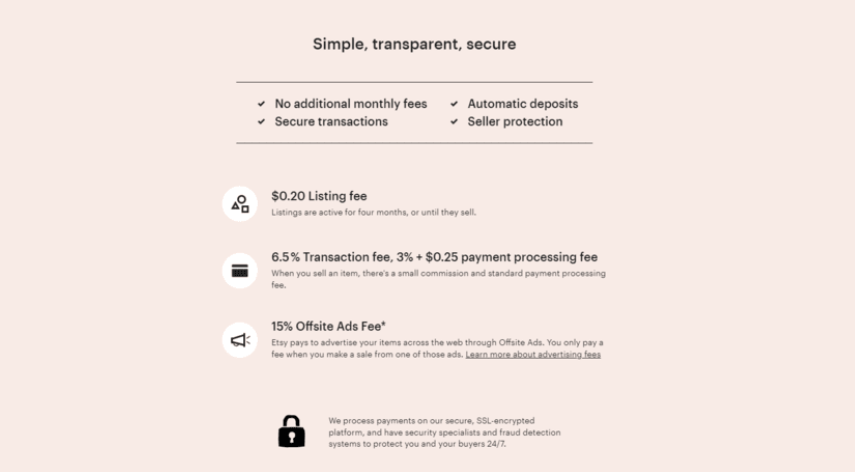
Meanwhile, Etsy charges 3% plus 25 cents per transaction, but that’s not all. There’s also a sneaky transaction fee of 6.5%, and you have to pay 20 cents for each new product listing. While listings do stay active for four months, these extra fees can quickly add up.
🔸 Integrations
Both platforms offer various integrations with third-party tools and services. These integrations can help you streamline your operations, improve your marketing, and more.
Also, when it comes to dropshipping your products over social platforms, Shopify provides a remarkable feature for your dropshipping business, called omnichannel commerce.
Thus, it enables you to list your products on various third-party shopping platforms, such as Instagram, TikTok, Walmart, etc.

In contrast to Shopify vs Etsy, Etsy does not offer such extensive integrations. While sellers can create social media posts from their Etsy dashboard and add listings to Facebook or Instagram shops, they must manually create listings to sell on other platforms.
Store Ownership
While Etsy offers a convenient platform for sellers to reach a wide audience, it’s important to consider who really owns your business in this marketplace.
Thus, Etsy controls customer data, relationships, and the very store where you’re selling your products. Additionally, Etsy’s SEO algorithm changes can suddenly and negatively impact your sales.
However, if you want to maintain ownership and control over your dropshipping brand, it’s wise to consider setting up your own dropshipping store on your own domain. This is where Shopify shines as a powerful e-commerce solution, allowing you to have complete control over your customer list, marketing, and the store itself.
Etsy vs Shopify: Pros & Cons
Etsy Pros & Cons
✅ Pros
➡ Instant access to a pre-existing audience and traffic
There are over 350M visitors in a month on this platform. So, you have a great potential to reach a vast audience.
➡ Lower financial risk
First, there’s no upfront investment in websites or advertising. What’s more, Etsy has already established its brand and generated traffic, so you can take advantage of it without additional costs.
➡ Relatively easy setup process for creating a store
Setting up your dropshipping store on Etsy is relatively easy. It requires a few easy steps to set up your products and personal info, and there you go!
❌ Cons
➡ Lack of store ownership and control over customer data
As with any other marketplace, Etsy owns everything from your store to customer data and relationships.
➡ Limited ability to customize and control the brand and design of the store
Unfortunately, there’s only a little room for customization and design on Etsy.
➡ Additional fees for listings and transactions on top of commission fees
Shopify Pros & Cons
✅ Pros
➡ Wide range of customizable options
Shopify provides a wide range of customizable templates, allowing you to create a unique dropshipping store that represents your brand and vision.
➡ Store and customer data ownership
Shopify allows you to have complete control over your customer list, marketing, and the store itself.
➡ Variety of payment options
With Shopify Payments, you can accept a variety of payment options, including credit cards, Apple Pay, Google Pay, and more.
❌Cons
➡ Additional Transaction Fees
If you use a third-party payment gateway, Shopify charges an additional transaction fee on top of the fee charged by the gateway.
➡ Additional Costs
Many of the apps available in the Shopify App Store are not free and can add up to additional costs.
➡ No immediate traffic
When it comes to traffic, you are completely on your own, since you need to drive traffic from scratch.
Shopify Vs Etsy: Marketplace or Ecommerce platform?
Firstly, this might be one of the biggest differences between the two platforms. Plus, the most significant one.
So, Shopify empowers merchants to create their own ecommerce website with a suite of powerful tools and apps, streamlining the process of setting up and growing a dropshipping store. Therefore, Shopify is an eCommerce platform.
On the other hand, Etsy operates as a marketplace that caters specifically to handmade, vintage, or craft goods.
In addition, while Shopify offers complete control over branding and website customization, Etsy offers access to a vast pool of buyers who are specifically seeking out unique and creative products.
Now, by understanding the key differences between these two ecommerce platforms, let’s continue with a more in-depth Shopify vs Etsy comparison.
Shopify Vs Etsy: Pricing Plans Comparison
Etsy Pricing Plans
There are three pricing plans that Etsy offers:
- Standard – $0/month
- Plus Plan – $10/month
- Pattern Plan – $15/month
Etsy Standard Plan – FREE
Firstly, the Etsy standard plan is completely free. So, you have access to the seller dashboard, which allows you to track orders, communicate with customers, and receive notifications about critical issues such as expiring listings.
Plus, the dashboard also provides valuable insights into your dropshipping store performance, such as the number of views and revenue generated.
However, the standard Etsy plan may be affordable, but it comes with its limitations.
Etsy Plus Plan – $10/month
If you are looking for more design freedom consider upgrading to Etsy Plus. This plan includes all the features of the standard plan but with even more perks.
Here you can also enjoy 15 monthly listing credits (valued at $3) and a $5 credit for Etsy Ads. Plus, you get discounts on shipping boxes and business cards.
With Etsy Plus, you can offer customers restock alerts and customize your shop page with banner images and featured items. Also, it includes four customized carousel or collage banners, and out-of-stock products with email notifications.
Etsy Pattern Plan – $15/month
The Pattern plan allows you to set up your own dropshipping store with a unique domain name. However, you will still list items on Etsy and power your store through Etsy’s dashboard.

However, always keep this in mind! All Etsy pricing plans have additional fees. So, let’s list them.👇
- Listing Fees. These fees are charged every time you create a new listing on Etsy, with each item listed costing $0.20. However, if you list multiple quantities of the same product, you only pay the fee once.
- Transaction Fees. These are Etsy’s fees for each sale, including product customization and gift wrapping. The fee is 5% of the transaction total.
- Payment Processing Fees. These are charged by the payment processor you use, such as PayPal or Stripe. Etsy doesn’t receive this fee, but you’ll need to factor it into your costs. Payment processors usually charge around 2.9% + $0.30 per transaction.
- In-Person Selling Fees. If you charge your customers for shipping, Etsy will collect 5% of the total shipping cost. There’s also an In-Person Selling Fee of 2.6% + $0.10 per transaction if you’re using the Square POS system to sell offline.
- Etsy Pattern Fees. These fees only apply if you use Etsy’s online store platform. The monthly subscription fee is $15/month.
- Ads Fees. Running ads is another option on Etsy. If you run ads within Etsy, you’re charged per click, and you have control over your costs. However, for ads on other platforms like Google, the fee is mandatory and ranges from 12% to 15% per sale.
- Currency Conversion Fees. Finally, if your listing currency and payment account currency don’t match, you’ll face a 2.5% currency conversion fee.
Shopify Pricing Plans
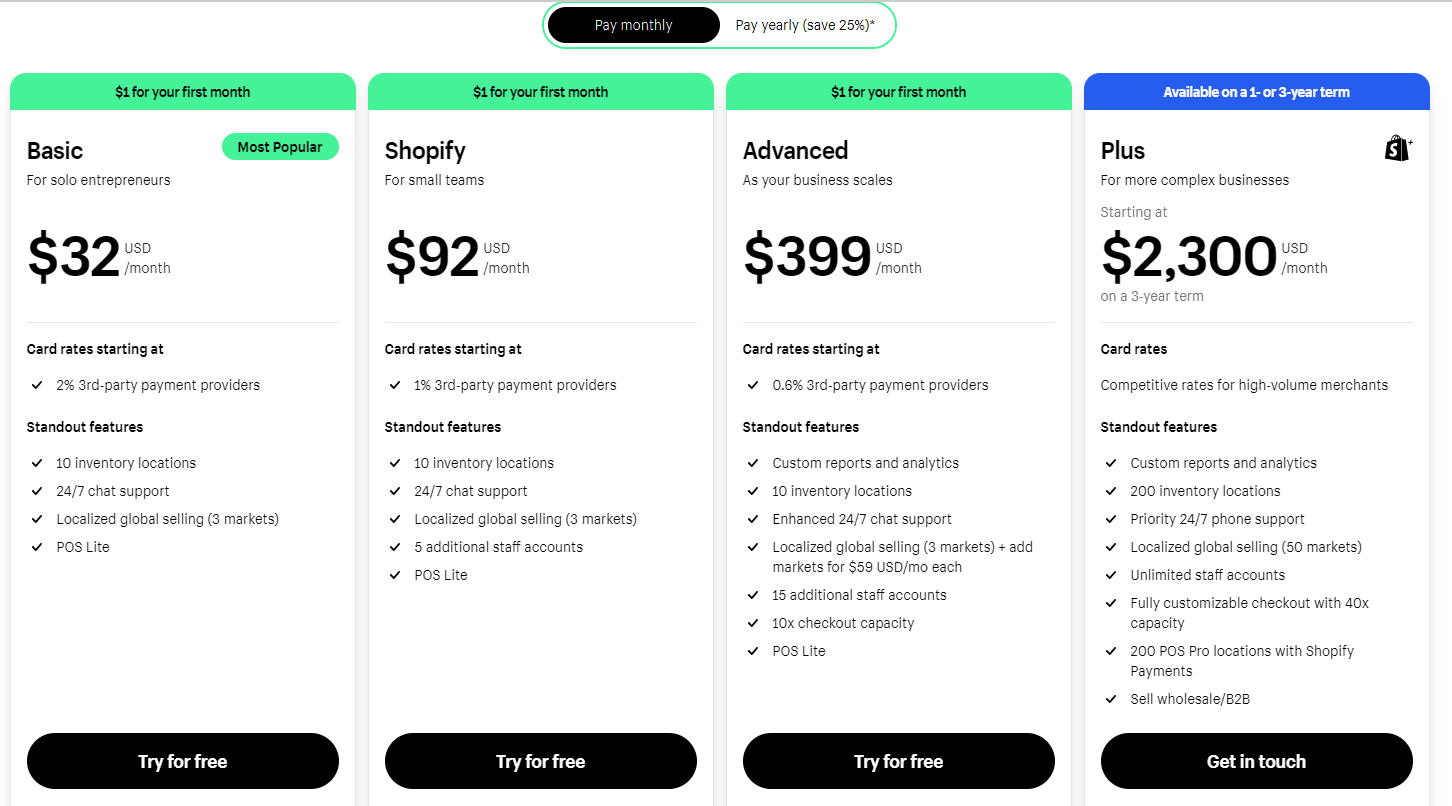
There are three main Shopify pricing plans:
- Shopify Basic – $32/month
- Shopify Regular – $92/month
- Shopify Advanced – $399/month
Shopify Plus – $2,300/month
With features such as website customization and a shopping cart, the Basic Shopify plan is ideal for dropshippers ready to take their online presence to the next level.
But that’s not all. You also have access to social media platforms like Instagram and Pinterest, as well as popular marketplaces like Amazon, eBay, and Google Shopping.
Furthermore, this pricing plan includes advanced features like abandoned cart recovery, fraud analysis, and 24/7 support, which can help you ensure your customers have the best shopping experience possible.
Additionally, the plan allows only 1 staff account, so you can delegate tasks and streamline your operations.
However, Basic Shopify has a transaction fee of 2.9% + 30¢ per transaction. Also, it’s important to note that using a different payment gateway than Shopify Payments can result in an extra 2% cost for each transaction.
Shopify Regular Plan – $92/month
The Shopify Regular pricing plan is designed for dropshipping businesses with a higher volume of sales and more complex requirements.
In addition, this Shopify plan includes all the features from the Basic Shopify plan and a range of powerful tools that can help take your dropshipping business to the next level.
With the ability to create up to five staff accounts, you can give your team the access they need to effectively manage your online store. Additionally, advanced report building and real-time carrier shipping can provide valuable insights and streamlined shipping processes.
One unique feature of this plan is the ability to offer gift cards for your store, which can be a powerful tool for customer retention and loyalty. The plan also includes access to Professional Reports, providing you with detailed insights into your sales, inventory, and customer data.
The Shopify Regular plan has a transaction fee of 2.4% + 30¢ per transaction.
Shopify Advanced Plan – $399/month
This Shopify plan offers all the features of the Basic and Regular plans, plus more advanced features.
Thus, with the ability to create up to 15 staff accounts, advanced report building, and real-time carrier shipping, duties, and import taxes, you can streamline your operations and increase efficiency.
Read more: How To Open and Manage Multiple Shopify Stores (Tips + Apps).
What’s more, the plan also includes access to the “Advanced Shopify” feature, which allows dropshippers to calculate and report on shipping rates, taxes, and discounts with ease.
We recommend this Shopify pricing plan for dropshipping businesses with a large volume of sales and more complex needs for inventory management, shipping, reporting, etc.
Plus, Advanced Shopify has a transaction fee of 2.4% + 30¢ per transaction.
💡 Tip: Read our FULL review for Shopify Pricing Plans: What’s The Cost Of Dropshipping With Shopify?
Furthermore, it is worth mentioning that regarding the three main Shopify plans, there are also two others:
Shopify Plus Plan – $2,300/month
Shopify Plus is a high-end ecommerce solution tailored for large-scale businesses, starting at $2,300 per month. This premium plan builds upon the standard Shopify features, catering specifically to merchants with high transaction volumes. Key enhancements include:
- Unlimited staff accounts
- Priority customer support
- Advanced data reporting and analytics
- Customizable checkout experiences
- The capacity to manage extensive orders and customer bases
- Support for up to 200 inventory locations
It’s important to note that the cost of Shopify Plus may adjust based on the merchant’s monthly sales, reflecting the specific needs of their business operations. Additionally, Shopify Plus maintains a minimal transaction fee of 0.2%.
Shopify Starter – start Shopify for $1 for 3 months, instead of 14 days free trial
Now, let’s see which one of Shopify vs Etsy is better for dropshipping.
Shopify Vs Etsy: Using Etsy For Dropshipping

While it’s true that getting started is relatively easy – register, upload, promote – there are some important considerations to keep in mind.
First and foremost, Etsy’s restrictions on what can be sold. In fact, it is limited to handmade items, vintage goods, and craft supplies. Therefore, this makes Etsy less than ideal for dropshipping.
Hence, you can technically use other businesses to dropship on Etsy. Also, it is possible to use Printful and Printify in conjunction with Etsy. These white-label dropshipping suppliers allow you to manufacture and deliver products to customers based on your own artwork and images.
👉 Read about Printful vs Printify – Which Platform Is Better for Print-on-demand Dropshipping?
Customization options
Furthermore, while Etsy provides a clean and attractive design to showcase your products and provide a great user experience, it also severely limits your ability to differentiate your store from others.

Thus, with only a few areas for customization, it can be challenging to set yourself apart from the competition. In fact, you can only customize:
- Store Name & Brand Logo
- Product Images & Descriptions
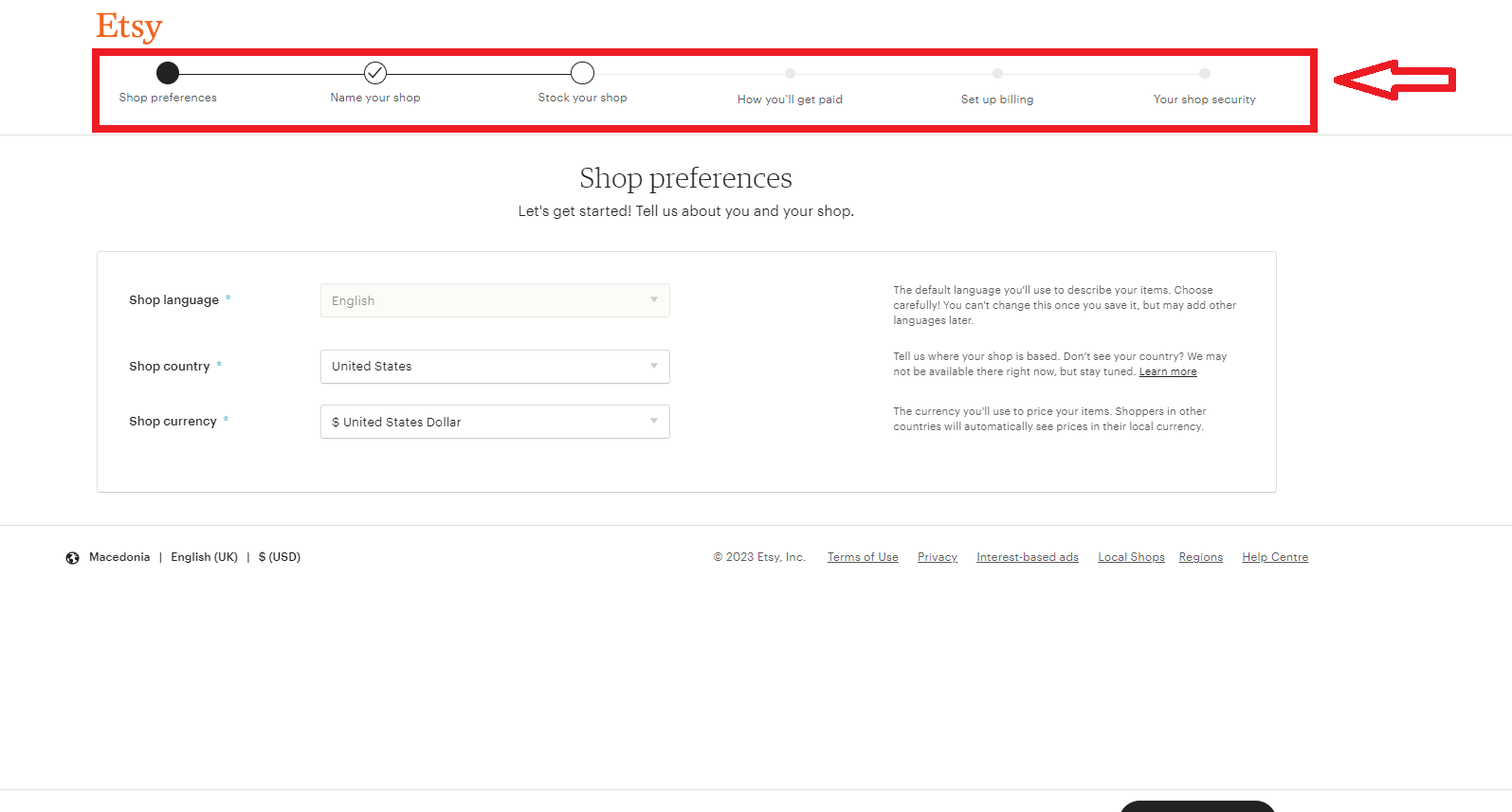
☝️ Launching an Etsy store is a streamlined process that consists of four easy-to-follow steps:
- Step 1 – Account Creation. Sign up and provide payment and billing details, along with shop preferences.
- Step 2 – Add Listing Media. Upload your listing images and videos to showcase your product.
- Step 3 – Listing Details. Fill in product details such as name, description, type, category, and more.
- Step 4 – Inventory & Pricing. Indicate the stock, variants, and price of each item, along with any personalization options.
- Step 5 – Shipping. Set clear and realistic shipping expectations, processing times, prices, locations, and services.
So, if you’re looking to create a unique dropshipping brand identity, Etsy may not be the optimal platform.
However, Etsy also offers apps and tools so you can manage your dropshipping business.

💡 Also, read our FULL review for Etsy Dropshipping – The Ultimate Guide for Beginners.
Shopify Vs Etsy: Using Shopify For Dropshipping
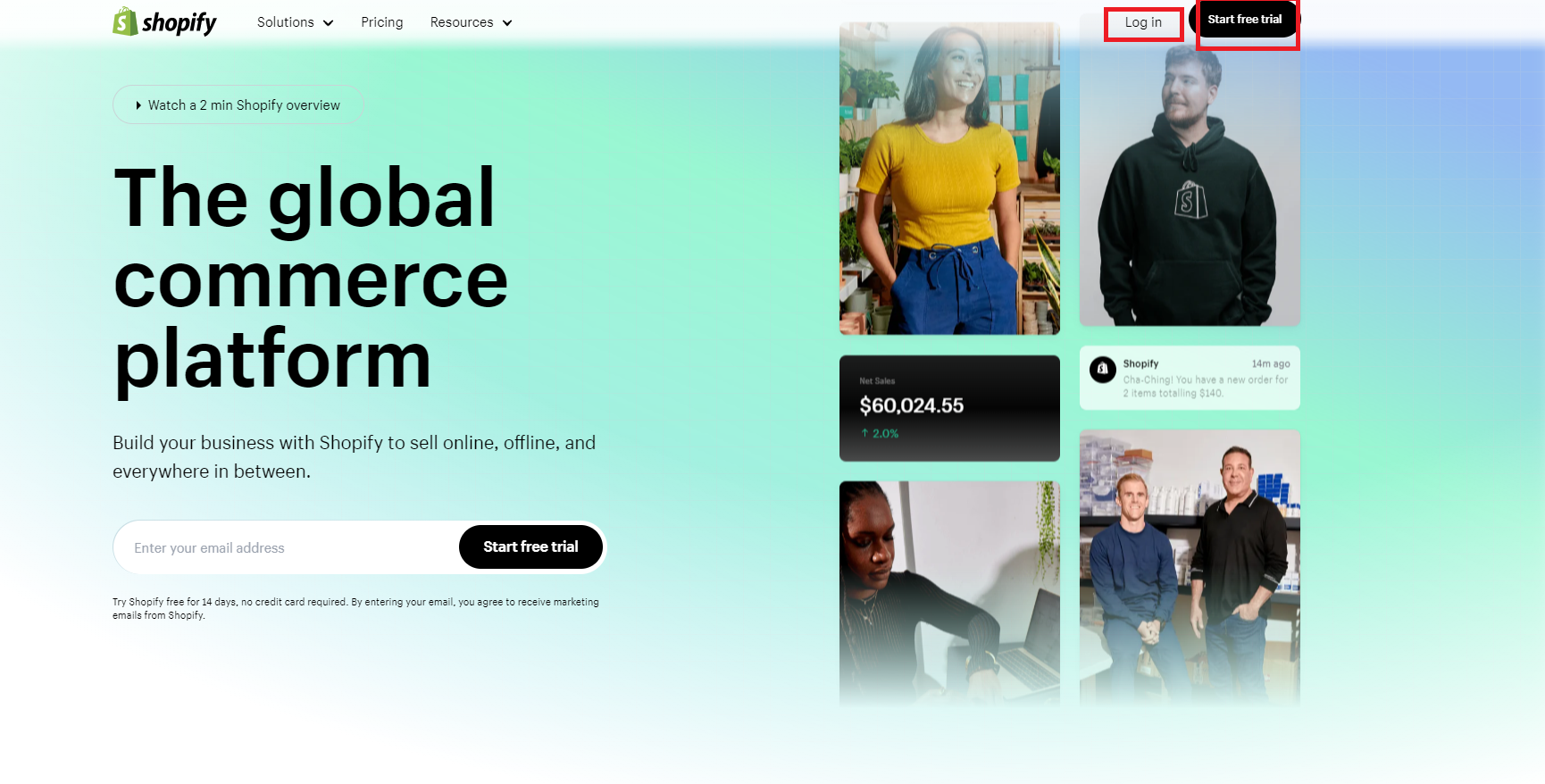
When it comes to dropshipping, Shopify is a clear front-runner in its ability to empower dropshippers to design their dream store without limitations.
Customization options
Unlike Etsy, Shopify’s collection of free and premium themes offers endless customization options that allow your brand’s personality to shine through.
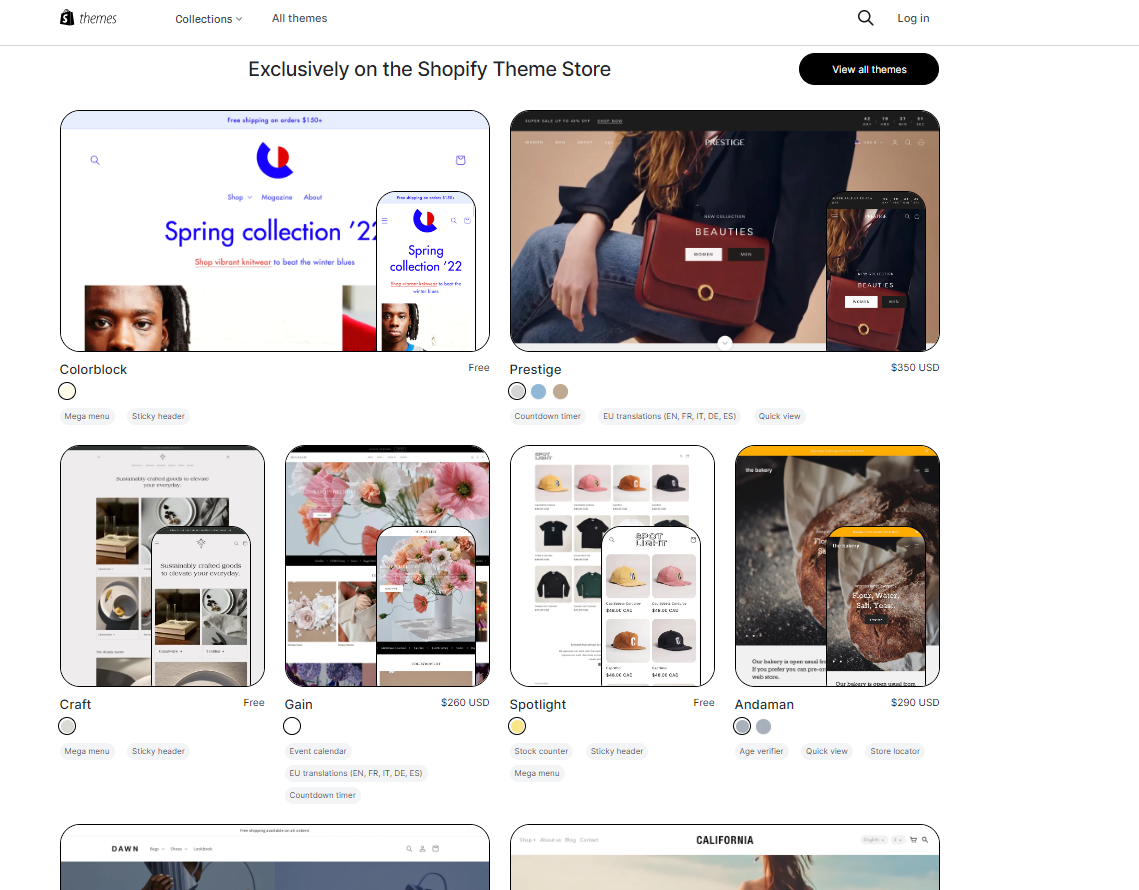
Plus, with their huge amount of customization options, from header to footer, and from home page to any other landing page, you can make it as you want.

But it’s not just about aesthetics – Shopify’s dropshipping features are outstanding. With access to a huge base of dropshipping suppliers, you can source and sell a diverse range of products without making a significant investment upfront.
Shopify Apps & Tools
What’s more, there are various Shopify apps and tools you can use to connect with these suppliers and manage your dropshipping store fully.👇
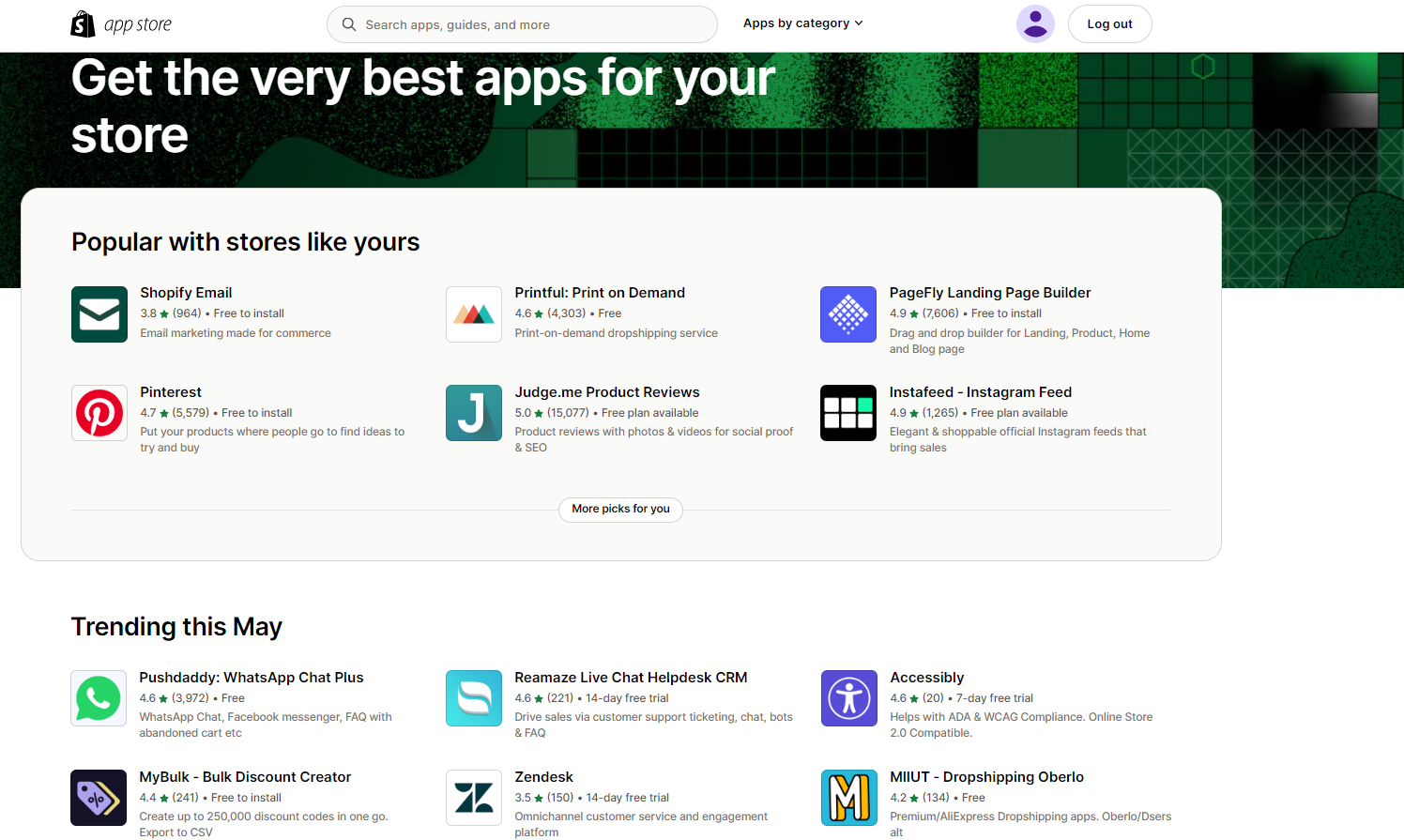
👉 Check out the 13 Best Shopify Wholesale Apps for Your Dropshipping Business.

☝️ In order to understand how Shopify works, here are 11 simple steps:
- Step 1 – Begin your Shopify journey by starting a free trial or choosing a monthly subscription. Simply click “Get started” and enter your email, password, and store name.
- Step 2 – Next, the dashboard has several key categories: Home, Orders, Products, Customers, Analytics, Marketing, Discounts, Apps, Online Store, and Settings.
- Step 3 – Manage your orders with ease. View and edit orders, create drafts for manual orders, and even track abandoned checkouts.
- Step 4 – Add products to your dropshipping store, and manage inventory levels, transfers, collections, and gift cards.
- Step 5 – Stay on top of customer relationships by adding new customers, importing existing ones, managing their details, etc.
- Step 6 – Unlock valuable insights into your online store’s performance with detailed analytics reports. You can even create custom reports and view a live snapshot of your store’s activity.
- Step 7 – Leverage marketing tools to create and manage campaigns, and explore marketing automation features to streamline your efforts.
- Step 8 – Create discount codes to incentivize customer purchases and boost sales.
- Step 9 – Enhance your store’s functionality by adding apps from Shopify’s vast library of options.
- Step 10 – Customize the look and feel of your dropshipping store by selecting a theme, setting up navigation, creating pages, managing your blog, and purchasing a domain.
- Step 11 – Set up the back end of your store, taking advantage of all the settings provided, including general, payment, checkout, shipping and delivery, taxes, navigation, and sales channels.
💡 Tip: Check out the 13 Most Successful Shopify Dropshipping Store Examples.
Selling On Etsy Vs Shopify
Shopify is the ultimate destination for entrepreneurs who want to create a customized and unique online store that reflects their brand. Over 4.4 million businesses have chosen Shopify as their go-to website-building platform.
Etsy, on the other hand, is a massive marketplace with over 7.4 million merchants and a staggering 95 million customers. So, it’s like selling your products in a bustling supermarket.
Now, selling on Shopify requires more effort as you’ll have to design your online store from scratch and attract your own customers. However, it also gives you complete control over your brand and store’s appearance, from the domain name to the way you sell your products.
On Etsy, the competition is fierce, but the customers are already there, making it a fantastic platform for getting started quickly.
🔸 What can you sell on Shopify vs Etsy?
First, on Shopify, you can sell everything! So, no matter what dropshipping niche you are into, Shopify lets you sell it, as it’s legal to do so in the country you’re based in.

On the other hand, your choices at Etsy are limited.
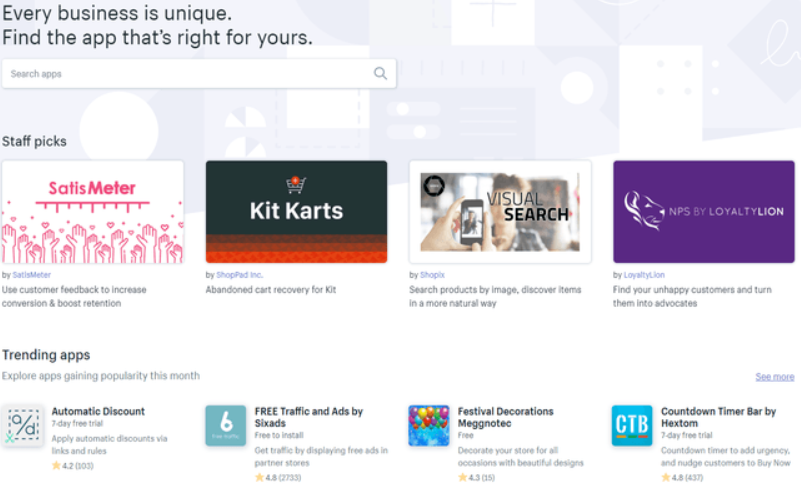
Hence, Etsy only lets you sell these types of products:
- Goods that are handmade by you.
- Vintage items (products that are at least 20 years old).
- Craft supplies (tools, ingredients, or materials whose purpose is for use in the creation of an item/occasion).
Also, both platforms enable you to sell unlimited physical and digital products. But, there are costs involved.
Shopify requires a monthly plan purchase starting at $32. On the other hand, Etsy is free to use but charges $0.20 per listing, in addition to other fees. More information on the costs of selling on each platform will be discussed later.
🔸 Marketing
Sales without marketing? Not even in a dream! That’s why, we must point out the marketing tactics of these two platforms. Thus, both platforms are great in front of marketing, but in a different way.
First, Etsy has a huge customer base. According to research, there are around 95 million customers right now. So, instead of attracting customers to your store, and bothering yourself with driving traffic, you already have them.
Also, you have the option to participate in Offsite Ads, which means you can display your items on Etsy’s own marketing and promotional channels.
However, you should keep in mind that there’s no building brand recognition.
On the other hand, to build a customer base on Shopify, you’ll need to invest significant effort in areas like SEO, content marketing, online advertising, email marketing, etc.
Thankfully, Shopify has it all! There are various Shopify marketing apps that can help you boost your dropshipping store.
👉 Check out the 7 Tips For Creating a Bulletproof Dropshipping Marketing Strategy in 2024.
🔸 Currencies & Languages
When it comes to reaching a global audience, language and currency can make all the difference.
With Shopify, you can cater to your audience’s language preferences by translating your dropshipping store into one of up to 20 languages. And with over 130 currencies available, you can also offer flexible payment options to customers worldwide.
However, Etsy is a bit more limited in this regard. While it does offer support for over 10 languages and 30 currencies, there are still some limitations to consider. For example, if you’re selling from the EU, the default currency will be EUR and not your local currency, which could create confusion for some customers.
Etsy Shopify Integration
Now, there’s also a way to sell on Etsy via Shopify. So, you can sync your data from Etsy as a source, or from Shopify as a source. And, that’s your choice.
Here we will show an example of Shopify as a source, and we will integrate it with Etsy. Let’s start!
However, before making an integration, you first must have an Etsy store and products listed.
After that, there are a few steps to perform. Let’s see!👇
Of course, first, Log in to your Shopify account. Next, head over to the Shopify app store and download the Etsy Marketplace Integration app.
For that purpose, we will use the app “Etsy Inventory Integration”. So, once you find it, click on “Add app”.👇
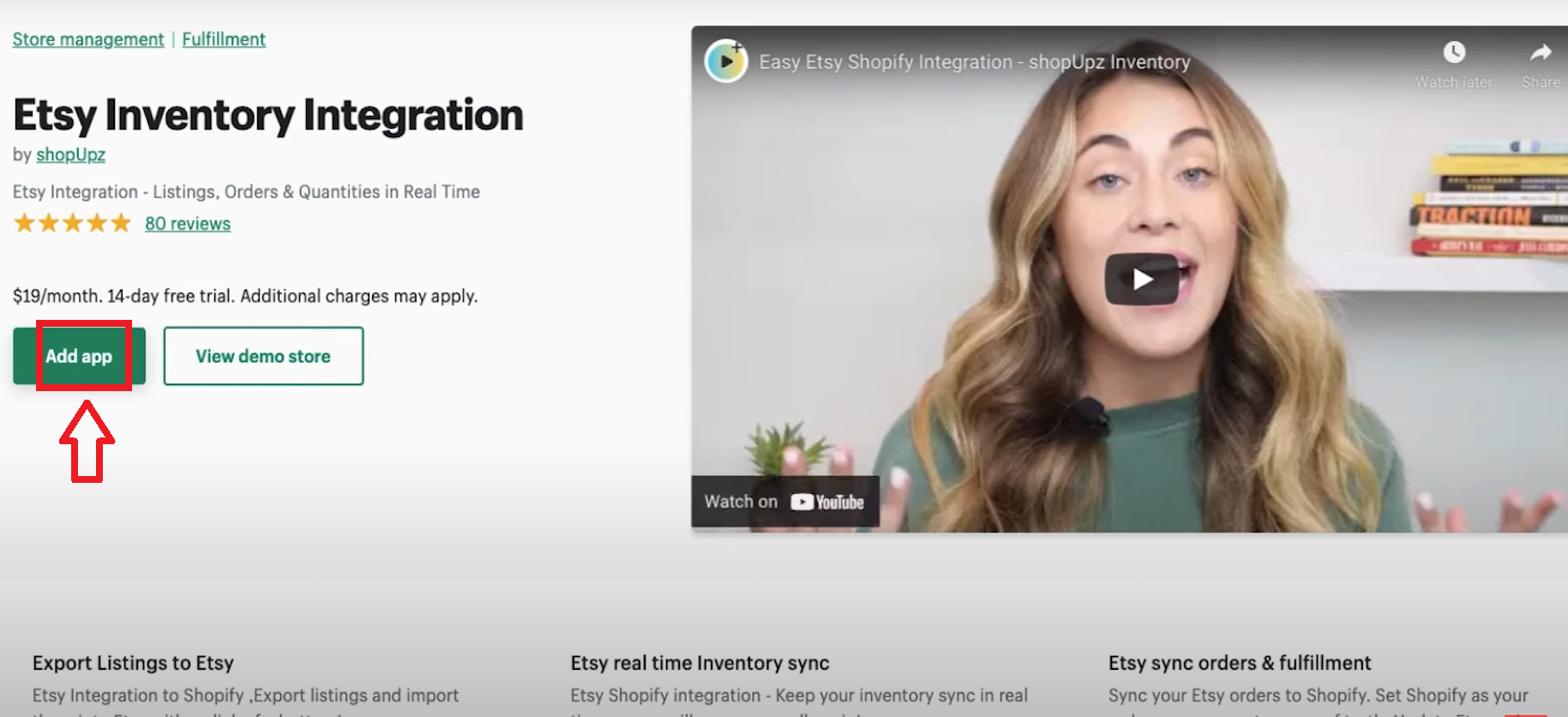
Once installed, locate the “Connect with Etsy” text block on the app’s homepage and enter your store name.👇

Then, another window will show up. So, click on the “Authenticate” button.👇

Finally, once you authenticate the connection, you will be led to Ets. Here you will have to allow the app to have access to your account. Thus, click “Allow Access” to complete the process.👇
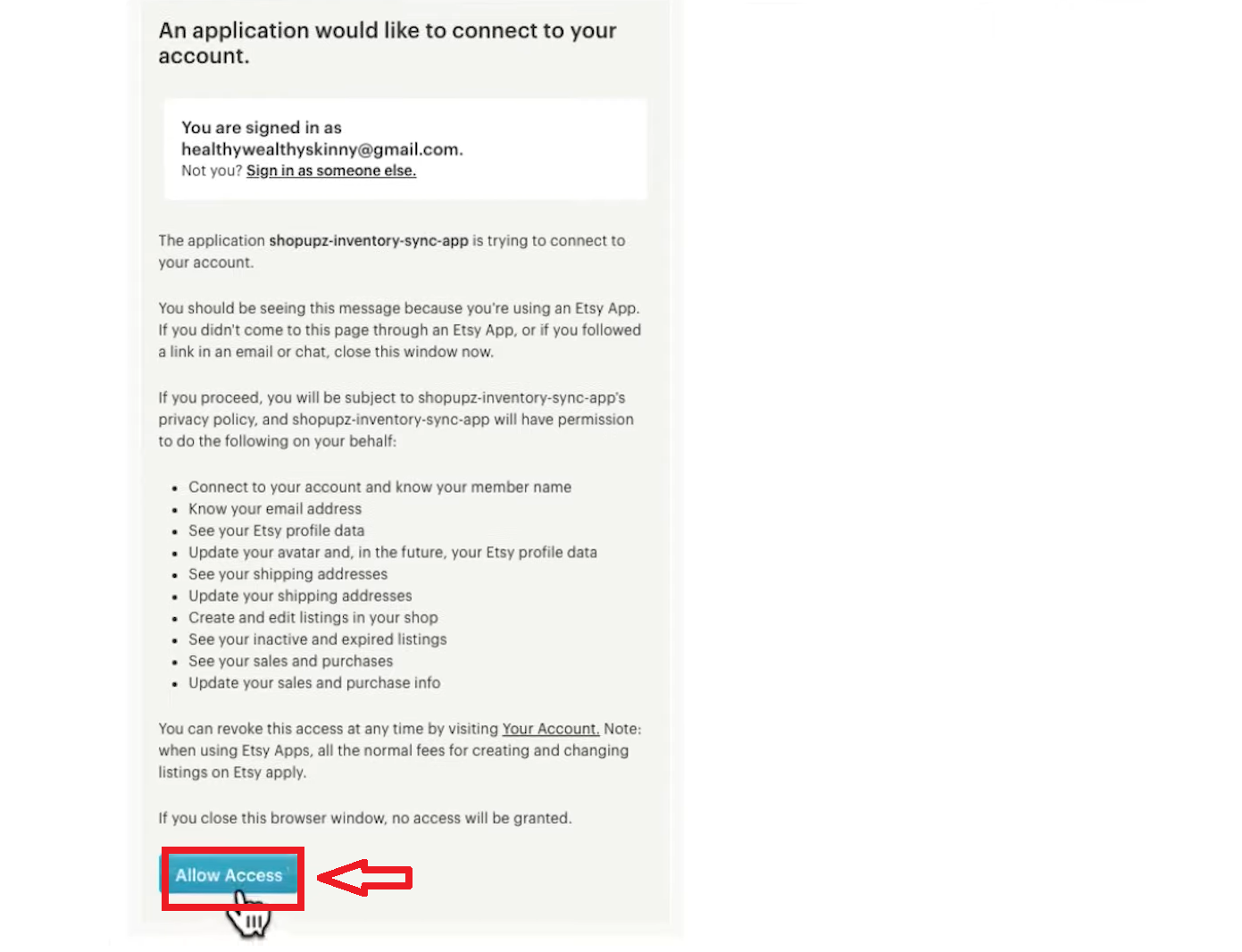
Next, if you want to customize your store on Etsy, you can do that from Etsy Store Manager. So, you can click Settings –> Info & Appearance.👇
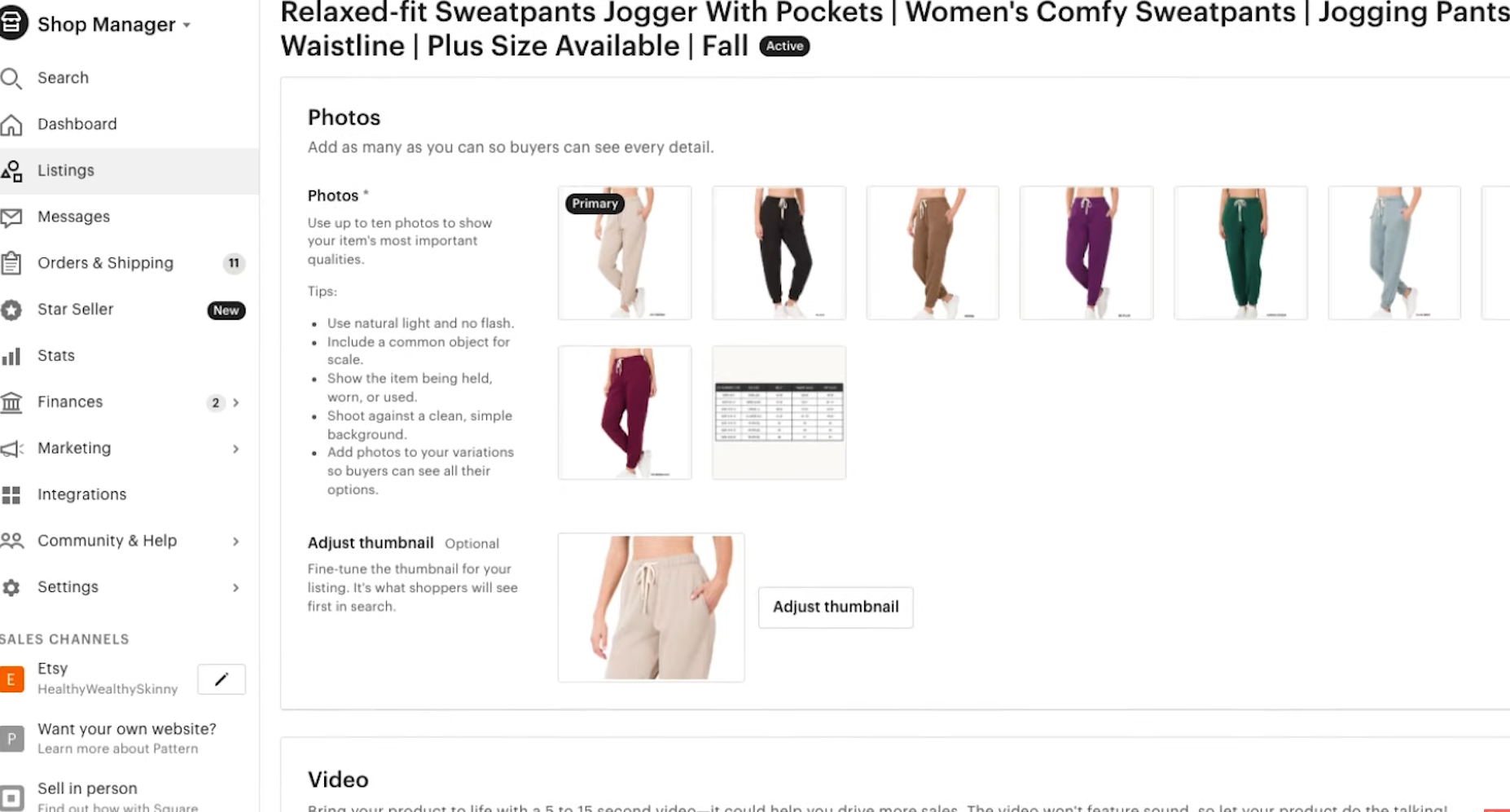
FAQs
Can you use Shopify and Etsy for free?
Yes, you can use both platforms for free. Shopify offers a 14-day free trial. On the other hand, Etsy offers a free plan.
Can you use Shopify and Etsy together?
Yes, many dropshippers use both platforms together. You can use Shopify to sell your products on your own dropshipping store and use Etsy to reach the marketplace’s audience as well.
Plus, you can integrate Shopify and Etsy data, from Shopify and from the Etsy platform as well.
Which platform has lower fees, Shopify or Etsy?
Etsy charges a listing fee of $0.20 per item, a transaction fee of 5%, and a payment processing fee of 3% plus $0.25 per transaction. Shopify charges a monthly subscription fee starting at $29 per month, and transaction fees ranging from 0.5% to 2.0%, depending on the payment method used.
Why use Shopify over Etsy?
If you want to build a dropshipping brand, have a wide range of customization options, or control over every aspect of your store choose Shopify.
Why use Etsy over Shopify?
If it is not important to differentiate yourself from competitors, or you want access to a ready-made and large audience, choose Etsy.
Is Etsy cheaper than Shopify?
Etsy is cheaper when you look at the upfront cost. If you’re on a tight budget, or you only want to sell a few items, Etsy will definitely be cheaper than Shopify. But, if you’re earning a lot of money in sales, Etsy’s 6.5% transaction fees could become expensive, making Shopify cheaper in the long run.


Conclusion
In conclusion, when it comes to choosing between Shopify and Etsy for your dropshipping business, it ultimately depends on your specific needs and preferences.
Shopify offers more features, customization options, and a user-friendly interface, making it ideal for those who want complete control over their store. However, it also requires more effort and investment to set up.
On the other hand, Etsy offers a simpler setup process, it is cheaper, has fewer customization options, and has a built-in audience, making it a great option for those who want to get started quickly and don’t mind working within its limitations.
Ultimately, both platforms are great choices, and it’s up to you to decide which one is the best fit for your dropshipping business. Or, simply, why not use them both together by integrating them?
So, get your info, and make a decision!













![The Top 21 3PL Companies Compared [2024 List & Guide]](https://images.weserv.nl/?url=https://prod-dropshipping-s3.s3.fr-par.scw.cloud/2024/03/Frame-3922469.jpg&w=420&q=90&output=webp)